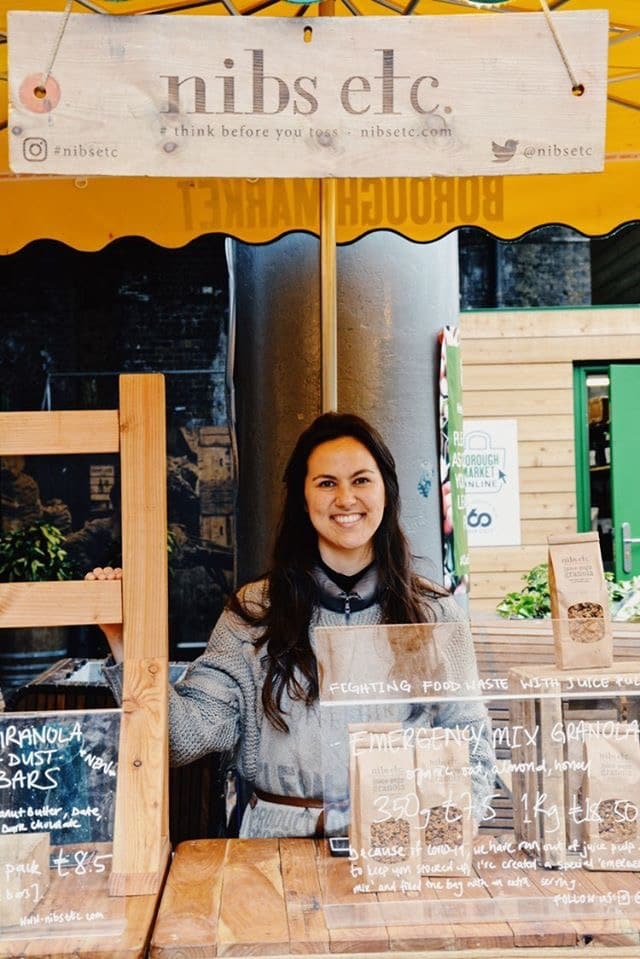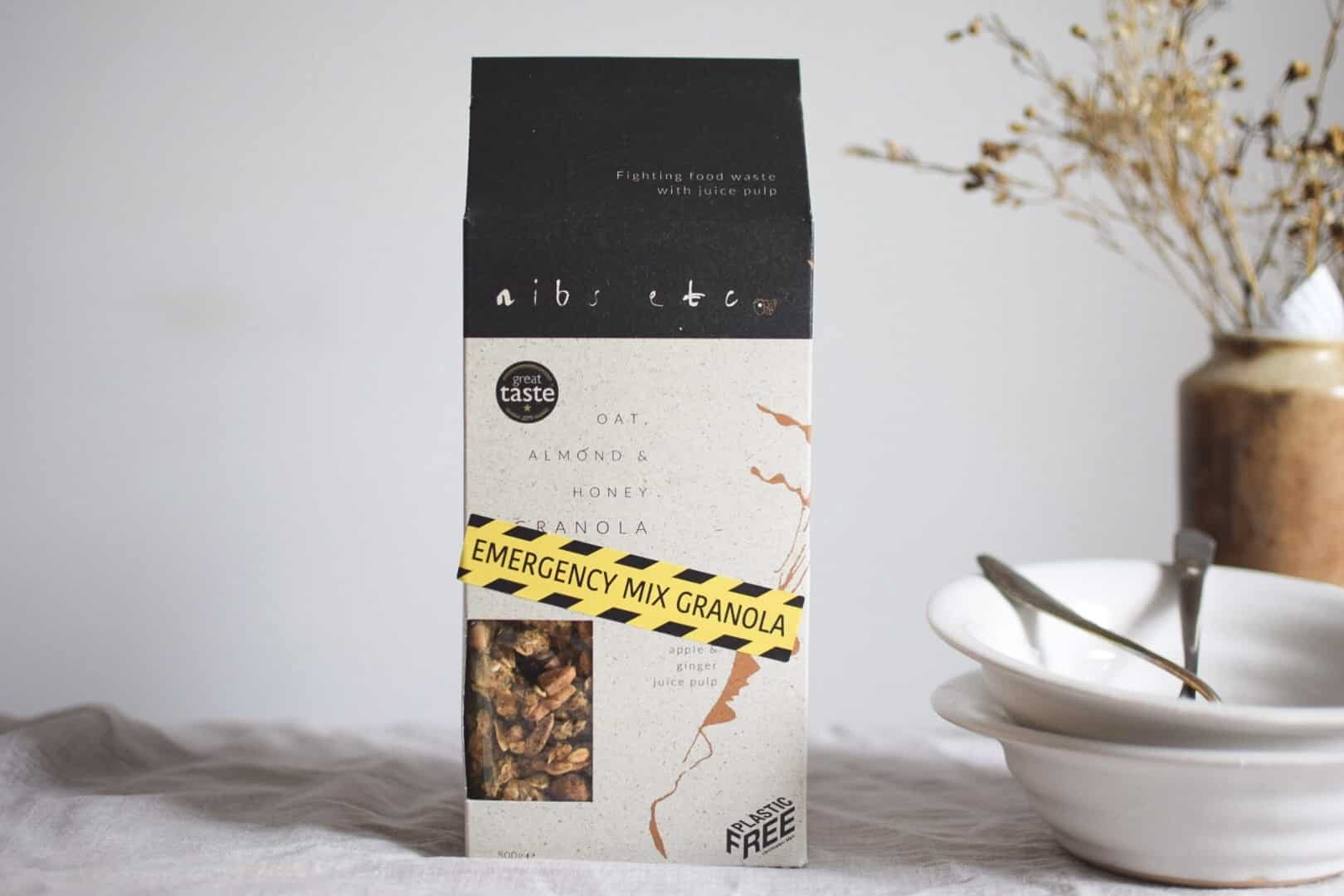We spoke to Chloë, founder of nibsetc, who creates delicious snacks out of food that would otherwise have been thrown away. Chloe shares her journey and talks about the challenges of running a small-scale sustainable business. We also spoke to Chloë about why it is important to include children in the discussion around food waste.
Tell us a little about Chloë and Nibsetc.
nibs etc. makes delicious and nourishing upcycled snacks from ingredient by-products that would otherwise be thrown away, to fight food waste. I am a self-proclaimed chocaholic, ethnic mutt, and food obsessor. I created a blog about upcycling leftovers and no waste recipes in 2015, mostly to satiate my own kitchen curiosities in a productively creative way. A year later, due to growing demand for this zero waste mentality and sustainable cooking, the blog evolved offline in the form of various events, yoga-brunch collaborations, supper clubs and popups. Along the way I befriended a wonderful juicer, who, to her great confusion and amusement, kindly allowed me to start experimenting with her pulp. A few years later, we have a stall at Borough Market, sell online and supply packaging free shops in East London, and the business has won several awards including a Great Taste Award for our revolutionary – and delicious – Oat, Almond & Honey Granola made with Carrot, Apple and Ginger Juice Pulp.
Where did your mission to fight food waste begin?
In hindsight, this is a journey that began long ago; from my parents encouraging us never to buy what we didn’t need and to finish what was on our plates, to living in China where the ‘nouveau riche’ expressed wealth in abundance – food included – to the US where portion sizes were enormous; although in San Francisco our compost was kept in the freezer and we shopped at local farmers’ markets. And at some point during my time in the US I had my first encounter with a pulp snack: pulp muffins. I went WWOOF-ing in Italy which was a beautiful reminder of how living, cooking, eating in a way that was constantly upcycling and never wasting is a way of life as old as time. It was after this that I started the blog, nibs etc.; a combination of frugal ‘new-grad-cooking’, laziness (the closest shop was ‘too far’ away), creative outlet (escape from an existential crisis), and childhood habits (some might call it hoarding).
What difficulties have you had a long way?
Fighting food waste is difficult for many reasons, not least because of the language that surrounds it; the fact that we even call it ‘waste’ is problematic. In nature, there is no such thing as ‘waste’. One system’s by-product is energy and resource for another. That is the beauty of a circular economy. And this is our mission with nibs etc. – to design the concept of waste out of our habits, our systems, our language. But because industry side streams, for example, are seen as ‘waste’, they are treated as such, and presumed ‘unsafe to eat’. This results in a lot of ‘red tape’ which is time and resource consuming to work around; which, for a small startup like us without the clout of the Kellog’s and Unilevers of the world, puts us in a weaker position to influence systemic change. On top of encouraging manufacturers to give us their by-products, we are also asking they do so using reusable containers to eliminate packaging waste. Packaging reuse and reverse logistics is something else that is new to a lot of the food supply chain, that requires time to test and implement. In a linear world, this goes against a manufacturing business’s goal to be as cost and time efficient as humanly possible. This throw-away culture and need for speed and convenience, all contribute to the challenges we’re facing in eliminating the concept of ‘waste’ all together.
Because of COVID-19, we lost our supply of juice pulp back in March last year. Either we would have to shut while we sourced new pulp, or we would have to tweak the recipe to keep our customers supplied and the business afloat while we looked for new by-product partners. We went with the latter, and communicated the changes with full transparency. Amazingly, with the understanding and support of our customers – and a lot of perseverance and reactive action! – we are still here; the business has grown, we introduced 6 new products, 4 of which are upcycled in some way, and finally launched our innovative, sustainable grasspaper packaging. We continue to search for juice pulp partners with every week that passes; progress has been admittedly slower than hoped, mostly due to the ongoing pandemic that leaves businesses struggling to adapt to a constantly changing environment and needing to be stricter than usual with delegation of resources. But consumer awareness around the issue of food waste and demand for transparent sustainability has never been greater than in this moment. We feel confident that things are moving in the ‘right’, circular direction.
Where would you like to see Nibsetc. in 5 years?
Big plans! We want to be the household brand for upcycled snacks. We will still have our pulp granola – and maybe the Emergency Mix too at this rate – along with 3 new upcycled snack lines reducing hundreds of tonnes of food from going to waste, reducing hundreds of tonnes of greenhouse gas emissions in the process. We also want to expand our circular supply chain internationally – Europe, Switzerland, Australia, the US; we are purposefully building with a modular approach so that we can work with local by-product, ingredient and manufacturing partners to support the local economies into which we grow, while reducing import/export miles. We want to continue to create content and share actions that inspire change and give people the tools with which to fight food waste, live by their values, and be activists from their kitchen table.
Why do you think it is important to teach children about food waste?
Without a doubt. It is no secret that a lot of our habits as adults are formed when we are young. Therefore, this conversation around food waste has to start in schools. Teaching children where food comes from, how it’s grown, how to cook and store it. With a greater understanding of this will come a greater respect for food itself: why would I throw away half a carrot when I’ve seen how much time and energy it takes to grow? And with this knowledge, a more innately less wasteful and more resourceful generation. It’s actually also a lesson in mindfulness; learning to make the most of what is within and in front of us, before reaching further afield for more of what we think we need. With each new generation comes a new generation of buying power and consumer influence. If we can positively influence the younger generations’ understanding of and relationship with food, their purchasing decisions will help us invest into more regenerative and circular food futures.
Do you have any advice, games or project ideas to encourage children to engage the food waste fight?
Yes! I’d love to see more schools try this: make being the least wasteful a competition, between students/teachers/homerooms. For exmple, at the end of lunch break, each table/homeroom tips all the food leftover on their plates into a bin the middle of the table. This bucket is weighed after each meal. The homeroom with the lightest bucket – ie. the least amount of food waste – over the course of a week/month/semester, gets rewarded. Part II idea: compost this food waste and take the competition to the creation of compost/growing of produce in a school veg. patch.
What is your go-to meal right now?
To be honest, I don’t really have one. For me, that’s part of the beauty and fun of bestover – best leftover – cooking. It’s always a little bit different! I try to allow the leftovers from the last meal direct me in the creation of the next. But, if I had to pick the most frequently appearing dish from the past year, it would have to be pasta. This for me is comfort food (and boy have I needed that this year). Specifically, with ratatouille – a dish I love to make in big batches to freeze, varying slightly from batch to batch based on seasonal availability, and so versatile when it comes to upcycling the leftovers (from ratatouille to caponata to shakshuka to soup – the possibilities are endless!).
If you were a fruit or vegetable, what would you be? And what would be your ‘hack’ (cooking or life)?
Oo this is a tough one. Either a carrot – I have eaten so many in one go that the palms of my hands and soles of my feet turned orange. Or a tomato – I have also been made fun of for whipping out a bag on the side of a volleyball court as a half time snack. I’m mostly picking these because I love them and can eat them at any time of day at any hunger level, not because I took a personality quiz once and was assigned a tomato… If you buy carrots with carrot tops, blanche the greens and blend with herbs, cheese and nuts to make a pesto. If you buy too many tomatoes and are worried they will go bad before you can eat them, or, they’re not great quality and mostly taste of floury water, roast them at 100*C for 1-4 hours (depending on size) with olive oil, salt and dried oregano. Flavour BOMB – also great for pesto making, or adding to salads and pasta dishes. Life hack: don’t buy what you don’t need – the most sustainable thing to use is what you already have. And of course, #ThinkBeforeYouToss .



